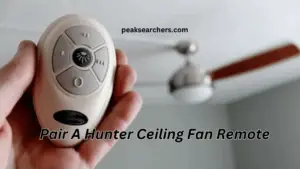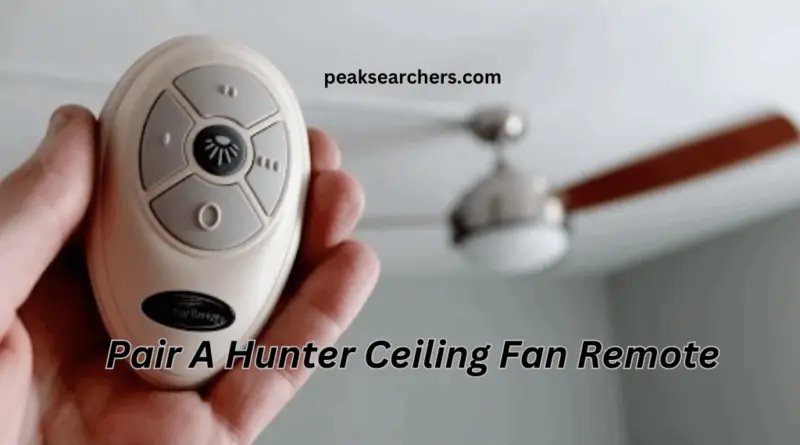How To Pair A Hunter Ceiling Fan Remote – Truth Revealed
If you’ve recently purchased a new Hunter ceiling fan with a remote control or need to pair an existing one for any reason, don’t worry – it’s easy! I did not know how to go through this process but with the consultation of a professional, I was able to do so.
I have mentioned all the points that I personally went through. In this step-by-step guide, we’ll show you how to pair a Hunter ceiling fan remote in no time at all. So let’s get started!

Pairing a Remote
The first step in pairing a Hunter ceiling fan remote is to turn off the power switch of your fan. Ensure that the circuit breaker is switched off too. Then, remove the battery cover from your remote and make sure that the dip switches on both the receiver and remote match. Match them by sliding them up or down until they are identical.
The next steps are mentioned down below in the article. Go through this guide to completely pair your remote.
Also go through: How To Remove A Hunter Ceiling Fan – A Step By Step Guide
Step 1: Identify Your Fan
Identifying your fan is the first step in pairing a Hunter ceiling fan remote. You can find the model number of your Hunter ceiling fan on the motor housing or inside the canopy, which is located at the top of the ceiling fixture. The model number will help you find information about your specific fan, including its compatibility with certain remotes.
Additionally, identifying your fan will allow you to determine if it has a built-in receiver or if one needs to be installed. Some Hunter ceiling fans come with pre-installed receivers that are compatible with certain remote models, while others require a separate receiver to be installed before pairing with a remote.
By taking the time to properly identify your Hunter ceiling fan and understand its compatibility requirements, you can ensure that you select and install a remote that will work seamlessly with your specific model. This will provide added convenience and comfort by allowing you to control your ceiling fan from anywhere in the room.
Step 2: Check the Control Type
After verifying the batteries, the next step to pair a Hunter ceiling fan remote is to check the control type. There are two types of control: pull chain and remote control.
If your fan has a pull chain, you need not perform this step. However, if your fan comes with a remote control, then read on. First off, you need to confirm that the receiver in your fan is compatible with the remote control you want to use.
Most Hunter fans come with pre-installed receivers that work only with specific remotes from Hunter or other brands. To know which remotes are compatible with your fan’s receiver, refer to its user manual or contact customer support.
Once you have identified the right remote for your fan’s receiver, make sure it matches or exceeds its features and functions.
For example, some remotes have multiple speed settings while others don’t; some have light-dimming options while others don’t. It’s best to choose a remote that meets all your needs and preferences for convenience and ease of use.
Step 3: Locate the Receiver
Once you have successfully accessed the canopy of your Hunter ceiling fan, you will need to locate the receiver. The receiver is a small box that typically hangs from the ceiling bracket or mounts directly onto the motor housing. It is responsible for receiving signals from the remote control and translating them into commands for the fan.
To locate the receiver, start by visually inspecting your fan’s canopy and motor housing for any visible wires or components that may resemble a receiver. If you’re having trouble locating it, consult your fan’s user manual or contact Hunter customer support for assistance.
Once you’ve identified the receiver, be sure to take note of its make and model number as this information will be necessary when programming your remote control. With the receiver in hand, move on to Step 4: Program Your Remote Control.
Step 4: Test Connections
Once you have installed the battery into your Hunter ceiling fan remote, you will need to test the connections. Start by making sure that your fan is turned on and running at one of its lowest speeds.
Hold down a button on the remote and observe whether or not the fan responds accordingly. If it does, then proceed to test all of the other buttons.
If you notice that there are any issues with connectivity, try moving closer to the fan or adjusting how you are holding the remote.
Additionally, make sure that there are no obstructions blocking the signal between your remote and ceiling fan. Finally, if none of these solutions work, consult your owner’s manual or contact customer service for further assistance.
Testing connections is an important step in pairing your Hunter ceiling fan remote because it ensures that all functions are working properly before use. By taking this step seriously and addressing any issues early on, you can avoid frustration down the road when trying to control your ceiling fan from afar.
Step 5: Program Remote
Once you have installed the batteries, it’s time to program your remote control. To do this, locate the dip switch settings on both the fan and the remote control. These switches will be small and may require a screwdriver to access them.
Next, set the fan’s dip switches according to your desired settings. Make sure that these match those on your remote control. Then, press and hold down the “fan off” button for approximately five seconds until you see a light flash on your remote.
Finally, test out your remote by pressing various buttons to ensure that they are working properly. If everything is functioning correctly, you can now enjoy all of the convenience that comes with having a ceiling fan with a remote control!
FAQ’s
Q: Can I pair a Hunter ceiling fan remote to multiple fans?
A: No, one remote can only be paired with one fan. If you have multiple fans that require remotes, each remote will need to be paired separately.
Q: Can I use a universal remote with my Hunter ceiling fan?
A: It specifically depends on the model of your Hunter ceiling fan. Some models are compatible with universal remotes, while others may require specific Hunter brand remotes. Refer to your owner’s manual or contact Hunter customer support for more information.
Q: How do I reset my Hunter ceiling fan remote?
A: To reset your Hunter ceiling fan remote, turn off the power to the fan at the circuit breaker or by unplugging it from the wall. You just need to wait for 30 seconds and then turn the power back on.
Within 3 minutes of restoring power, press and hold both the Fan Off button and Light On button on your remote until you hear a beep sound. This will reset your remote back to its factory settings.
Also read: Are Hunter Ceiling Fan Light Kits Interchangeable? A Complete Guide
Conclusion
In conclusion, successfully pairing your Hunter ceiling fan remote is a relatively simple process that can be accomplished in just a few easy steps. By following the manufacturer’s instructions and ensuring the remote and fan are in close proximity to each other, you can ensure a smooth pairing process.
Once the LED indicator light on the receiver has turned solid green, you can test out your new remote by adjusting the fan speed or turning it off and on.
It’s important to note that if you encounter any issues during the pairing process, such as difficulty syncing or an unresponsive LED light on the receiver, double-check that all connections are secure and try resetting both the fan and remote before attempting to pair them again.
Additionally, if you have multiple Hunter ceiling fans with remotes in your home, it may be necessary to label them with their corresponding receivers to avoid confusion.


